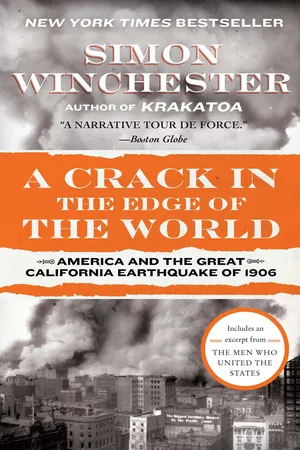![]()
APPENDIX
On Taking an Earthquake’s Measure
MOST OF THE PHYSICAL PHENOMENA THAT AFFECT OR afflict the planet can be measured, and thus recorded numerically. Temperature, for example, can be measured by a thermometer of some kind, and noted in degrees Fahrenheit or Celsius. Atmospheric pressure’s effects on a closed cylinder can similarly be related in millibars or the more modern units of hectopascals. Wind speed can be measured in knots or miles per hour, or, in cases where the wind affects the sea, by employing the famous scale that was first adopted by Admiral Sir Francis Beaufort* at the beginning of the nineteenth century. Tsunami waves have measurable heights and speeds. And even the eruption of a volcano can be assigned an index, although it is one determined with some difficulty: The amount of material estimated to have been expelled from the crater is multiplied by the height to which it is thrown up into the air.
ON INTENSITY
But earthquakes cannot be tidily transformed into numbers. They are so huge, unwieldy, and unpredictable that for most of human history they could only be suffered, defying classification by any kind of standard numerical arrangement. Instead, in the days before seismographs were invented, the only way of quantifying a quake was to do so subjectively, by looking at the damage it had caused, asking people exactly how they had experienced its shocks, and then assigning to it a number that described what by common consent came to be termed the quake’s intensity. This figure would very obviously vary—the intensity would be greatest near the earthquake’s epicenter, and it would diminish the farther an observer was away from it. The maximum intensity would provide some approximate measure of how big the event was when compared with another—but it would be a subjective assessment only and, moreover, one that required people who had been on hand, who had been affected and were fully aware, and who were intelligent enough to report. An earthquake that happened in an unpopulated area would pass unrecorded and unmeasured.
The first systematic investigation of intensity was probably the one conducted by Robert Mallet, the British engineer who first came up with the term seismograph in 1854. In late December 1857 he applied to the Royal Society for a travel grant to allow him to study in detail the great earthquake that had just occurred in Naples, and he spent two months there systematically observing what had evidently been a very major seismic event. Eventually he was able to draw maps showing the areas of the earthquake’s greatest evident intensity, with lines—which he called isoseismals—connecting places that had suffered the same amount of damage, or where people or animals had experienced the same amount of shaking. From his map he was able to infer the center of the earthquake’s shaking, and was also able to show how the intensity diminished with distance from this center. Once he compared his survey with the crude information that he was able to glean about other earthquakes, he was able to assign an approximate relative size to this Italian event: There was no possibility of giving the event an absolute size, but to be able to say whether it was greater or less great than another event in another part of the world did have some utility and purpose. His approach was, in consequence, seized upon by the earthquake scientists of the day as the best means available to determine a quake’s size—and over the years a number of these scientists examined data in more detail and developed formal scales of intensity, some of them still in use today.
The first of these intensity scales was developed in the 1880s by the Swiss scientists M. S. de Rossi and François Forel: It assigned ten values to earthquake intensities, which were numbered between I and X (Roman numerals were the most popular convention for intensity scales, and they are still in general use today). In the Rossi-Forel scheme the number I signified a slight quake, one rather confusingly defined as having been recorded by a single seismograph or by some seismographs of the same pattern, but not by several seismographs of different kinds; and with the shock felt also by an experienced observer. At the other end of the scale the number “X” was used to designate a seismic happening that was marked by great disasters, ruins, disturbance of strata, fissures in the earth’s crust, rock falls from mountains. Between I and X were all the more common earthquakes that wrought more or less damage and occasioned more or less havoc or casualties—and so a quake with intensity VIII was very bad, while an event of recorded intensity III was just this side of bearable.
Despite this vague and somewhat ambiguous calibration, the Rossi-Forel Scale became in short order enormously popular among seismologists and, perhaps more important, with the public, which found it easy to appreciate. It was in consequence used to describe most of the major seismic events that occurred in the Western world during the last quarter of the nineteenth century.
Before long, however, it was seen that the Rossi–Forel Scale had some important shortcomings. Engineers reported that the damage sustained by a city’s buildings—whose collapses and other sufferings were used as prime indicators of the intensity of the earthquake that had affected them—was determined not only by the strength of an earthquake, but also by how the buildings had been constructed in the first place (which meant that Japanese earthquakes, for instance, caused very different kinds of damage to the local wood-and-paper houses—a realization that caused a whole new scale, the seven-step Omori Scale, to be invented to deal with ...
